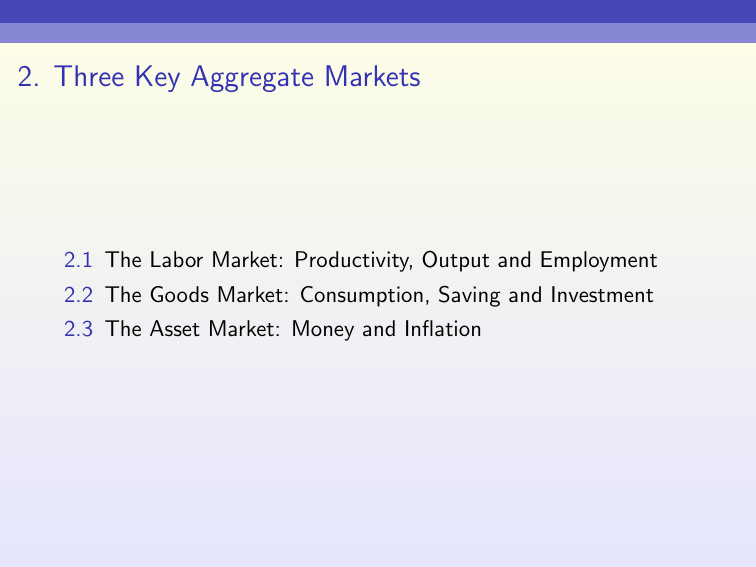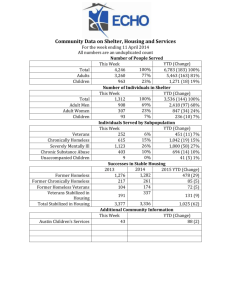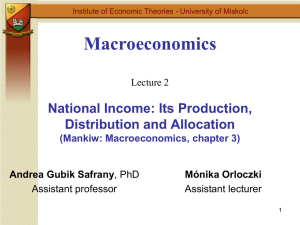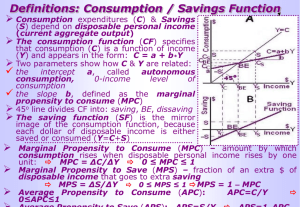Goods market slides
advertisement

2. Three Key Aggregate Markets 2.1 The Labor Market: Productivity, Output and Employment 2.2 The Goods Market: Consumption, Saving and Investment 2.3 The Asset Market: Money and Inflation 2.2 The Goods Market: Consumption, Saving and Investment Last chapter: determination of the real wage in labor market equilibrium This chapter: determination of the real interest rate in goods market equilibrium Consumption and Saving Investment Recall the income-expenditure identity: Y = C + I + G + NX The total aggregate demand for domestic goods consists of the sum of demand for goods for consumption C demand for goods for investment I net demand for domestic goods NX demand for goods for government uses G The Trade Balance NX Assumption 1: The economy is closed No international trade, the trade balance is zero, i.e. NX = 0 No net factor payments, i.e. NFP = 0 Therefore the current account CA = NX + NFP = 0 We will consider the open economy later. Government Spending G Assumption 2a: Demand for goods on behalf of the government is given, G = Ḡ Assumption 2b: Taxes are given, T = T̄ Government spending G and taxation T are determined by the political process We treat them as exogenous variables. Assume no transfers, TR = 0 Note the government budget deficit: D govt = Ḡ + INT − T̄ . Consumption and Saving Under assumptions 1, 2a and 2b: Private disposable income Y d is given by Y d = Y + INT − T̄ National saving S is given by S = Y − C − Ḡ = I Households allocate Y d for saving or consumption: Yd = Y + INT − T̄ Y d = S + C + Ḡ + INT − T̄ Y d = S priv + C Consumption and Saving Y d = S priv + C Understanding consumption requires understanding the savings decision. Trade-off between current consumption and future consumption Assumption 3: Trade-off occurs through utility maximization Utility Maximization Household chooses Ct and Ct+1 to maximize utility U(ct , ct+1 ) = u(ct ) + βu(ct+1 ) where ct is real current consumption ct+1 is real future consumption 0 < β < 1 is a discount factor that captures impatience subject to period t budget constraint Pt ct + St = Ytd d + (1 + i )S period t + 1 budget constraint Pt+1 ct+1 = Yt+1 t t where it is the nominal interest rate. Equivalent to choosing St to maximize d d Yt+1 + (1 + it )St Yt − St u + βu Pt Pt+1 Optimality requires − uc (ct+1 ) uc (ct ) +β (1 + it ) = 0 Pt Pt+1 where uc is the first derivative and denotes marginal utility. Saving one additional dollar more in t, means consuming 1/Pt less in t which lowers utility by uc (ct )/Pt Saving one additional dollar more in t, means consuming (1 + it )/Pt+1 more in t + 1 which increases utility by t+1 ) β ucP(ct+1 (1 + it ). marginal cost of saving = marginal benefit of saving A Specific Example Suppose that 1 u(c) = c 1− σ ,σ > 0 1 − σ1 Then −1 ct σ Pt ⇔ ct ⇔ ct ⇔ ct −1 c σ = β t+1 (1 + it ) Pt+1 −σ Pt (1 + it ) = ct+1 β Pt+1 −σ 1 + it = ct+1 β 1 + πt+1 = ct+1 (β(1 + rt )) rt is the real interest rate 1+it Note that 1 + rt = 1+π ≈ 1 + it − πt+1 t+1 −σ Consider again the budget constraints Pt ct + St = Ytd d Pt+1 ct+1 = Yt+1 + (1 + it )St We can eliminate St and write Pt+1 ct+1 1 + it ct+1 ⇔ ct + 1 + rt Pt ct + d Yt+1 1 + it yd = ytd + t+1 1 + rt = Ytd + d d /P where ytd = Ytd /Pt and yt+1 = Yt+1 t+1 denote real disposable incomes. Final step: use ct = ct+1 (β(1 + rt ))−σ ⇔ ct+1 = ct (β(1 + rt ))σ and plug into ct ⇔ ct ⇔ ct d yt+1 ct+1 − 1 + rt 1 + rt d y ct (β(1 + rt ))σ = ytd + t+1 − 1 + rt 1 + rt " # d −1 y = ytd + t+1 1 + β σ (1 + rt )σ−1 1 + rt = ytd + This last expression allows us to evaluate the determinants of consumption ct = −1 yd ytd + t+1 1 + β σ (1 + rt )σ−1 1 + rt −1 of the net Result 1 Consumption is a fraction 1 + β σ (1 + rt )σ−1 h i d yt+1 d present value (NPV) of lifetime wealth yt + 1+rt There is consumption smoothing. Result 2 Current consumption ct increases with current real disposable income ytd Result 3 Current consumption ct increases with future real disposable income d yt+1 ct = −1 yd ytd + t+1 1 + β σ (1 + rt )σ−1 1 + rt Result 4 The result of an increase in the real interest rate rt on current consumption is ambiguous Substitution effect −: rt ↑ makes saving more attractive and ct ↓. Depends on σ, the elasticity of intertemporal substitution. Income effect +: Keeping fixed the NPV of lifetime wealth rt ↑ lowers the price of ct+1 and expands the feasible consumption set, leading to ct ↑ Wealth effect −: rt ↑ decreases the NPV of lifetime wealth and ct ↓ Note, in reality πt+1 is unknown in period t and rt is the real expected interest rate " yd ytd + t+1 1 + rt # ct = ct = cta + MPCt ytd 1 + β σ (1 + rt )σ−1 −1 The marginal propensity to consume (MPC ): If current real disposable income ytd increases, how much does current consumption ct increase? MPCt = 1+ 1 + rt )σ−1 ) (β σ (1 0 < MPC < 1 if σ > 1, substitution effect dominates income effect and − MPCt (rt ) if σ < 1, income effect dominates substitution effect and + MPCt (rt ) Question: Do tax rebates stimulate consumer spending? A tax rebate of $800 raises ytd by $800/Pt The rebate must be financed today by increased government borrowing at an interest rate 1 + it . But must eventually be paid by higher taxes in the future: so d yt+1 decreases by (1 + it )$800/Pt+1 = (1 + rt )$800/Pt The NPV of lifetime wealth is unchanged: " # d − (1 + r )$800/P yt+1 yd t t d yt + $800/Pt + = ytd + t+1 1 + rt 1 + rt Ricardian Equivalence: Tax rebates have no effect on consumption! Theoretical prediction: most consumers will save their tax rebates and not spend them (as in rebate of 2001). Summarizing what we have so far: Y =P − c a (rt ) Y = C + I + Ḡ + MPC × y d + I + Ḡ − Y = C a (rt ) + MPC × Y d + I + Ḡ Ḡ exogenous C depends positively on current disposable income Y d through MPC We will assume from now on that σ ≈ 1 and therefore that MPC is constant and C depends negatively on rt . We still need to determine what drives investment I . Investment Why is investment important? Investment fluctuates sharply over the business cycle, so we need to understand investment to understand the business cycle Investment plays a crucial role in economic growth: Kt+1 = (1 − δ)Kt + xt where xt is real investment and Kt is the real capital stock and remember ∆yt ∆At ∆Kt ∆Nt = +α + (1 − α) yt At Kt Nt In the previous chapter we derived the demand for capital K d = (Aα) 1 1−α − 1 1−α R N P Demand for capital is such that MPK = R P R P is real the rental price of capital or the user cost of capital Demand for capital depends negatively on the user cost of capital R =r +δ P foregone real interest rt depreciation δ For someone that saves by buying e.g. a government bond: − uc (ct ) uc (ct+1 ) +β (1 + it ) = 0 Pt Pt+1 For someone that saves by a buying a unit of capital in t and rents it out to firms in t + 1: uc (ct+1 ) Rt+1 + Pt+1 (1 − δ) uc (ct ) +β =0 − Pt Pt+1 Pt Therefore (1 + it ) = Pt (1 + it ) Pt+1 = 1 + rt = ⇔ Rt+1 Pt+1 Rt+1 + Pt+1 (1 − δ) Pt Rt+1 + (1 − δ) Pt+1 Rt+1 + (1 − δ) Pt+1 = rt + δ Rt+1 = rt + δ Pt+1 Rt+1 Pt+1 If today’s real interest rate is high, tomorrow’s user cost is high, the desired capital stock for tomorrow is low. ⇒ today’s investment is low If today’s real interest rate is low, tomorrow’s user cost low, the desired capital stock for tomorrow is high. ⇒ today’s investment is high Rt+1 Pt+1 Again note, in reality the future is unknown and rt is the expected real interest rate. Bottomline: Demand for investment depends negatively on the (expected) real interest rate! is 1 1 − 1−α d Kt+1 = (At+1 α) 1−α (rt + δ) d Kt+1 = (1 − δ)Kt + xt Nt+1 Result 1 Current investment xt = PItt depends negatively on rt since it increases the user cost of capital which lowers the desired capital d stock Kt+1 . Result 2 Current investment xt = PItt depends positively on total factor productivity tomorrow At+1 because it raises the desired capital d stock Kt+1 . Result 3 Current investment xt = PItt depends positively on labor input d tomorrow Nt+1 because it raises the desired capital stock Kt+1 . Summarizing what we have so far: Y =P − c a (rt ) Y = C + I + Ḡ + MPC × y d + I (rt ) + Ḡ − − Y = C a (rt ) + MPC × Y d + I (rt ) + Ḡ Ḡ exogenous C depends positively on current disposable income Y d through MPC , and negatively on rt I depends negatively on rt . Goods market equilibrium Recall that in a closed economy: S = I = S priv − D govt We took D govt as exogenous S priv = Y d − C private savings increases with r , therefore national saving S increases with r I decreases with the real interest rate Goods market equilibrium occurs at the real interest rate r for which savings equal investment. Saving-Investment Diagram Shifts in the Saving Curve e.g. higher current or future disposable income Shifts in the Investment Curve e.g. higher future productivity, employment The Real Interest Rate






